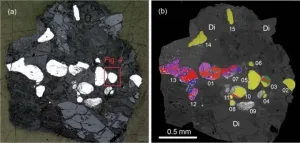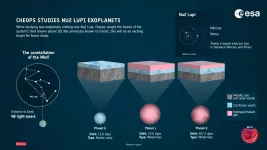(Press-News.org) A connective tissue protein known to support the framework of organs also encourages immune responses that fight bacterial infections, while restraining responses that can be deadly in the condition called sepsis, a new study finds.
Led by researchers from NYU Grossman School of Medicine, the work revolves around the extracellular matrix (ECM) of connective tissues, once thought of as an inert framework that shapes bodily compartments, but increasingly recognized as a signaling partner with nearby cells in normal function, and a contributor to disease when signals go awry. Among the key players in the ECM are fibroblasts, the cells that make tough structural matrix proteins like collagen.
Published online June 28 in the Proceedings of the National Academy of Sciences, the new analysis found that lumican, a protein-sugar combination (proteoglycan) secreted by fibroblasts, and known to partner with collagen in connective tissues, also promotes immune system responses in immune cells called macrophages that fight bacterial infections. At the same time, the study found that lumican protects tissues by restraining a different type of immune response that reacts to DNA, whether from an invading virus, or from human cells that spill their DNA as they die (a signal that tissues are under stress).
Such inflammatory responses represent as a transition into healing, but grow too big in sepsis, damaging the body's own tissues to the point of organ failure. Sepsis affects 48.9 million people worldwide, the authors say, but the role of the ECM in the condition is largely unknown.
"Lumican may have a dual protective role in ECM tissues, promoting defense against bacteria on the one hand, and on the other, limiting immune overreactions to DNA that cause self-attack, or autoimmunity," says corresponding study author Shukti Chakravarti, PhD, professor in the departments of Ophthalmology and Pathology at NYU Langone Health.
The findings suggest that connective tissue, and extracellular matrix proteins like lumican, operate outside of cells normally, but as disease or damage break down ECM, get sucked into and regulate immune cells homing in on the damage.
Maintaining the Balance
Lumican happens to interact with two proteins on surfaces of immune cells that control the activity of proteins called toll-like receptors known to recognize structural patterns common to molecules made by invading microbes, say the study authors. Because they are less specific than other parts of the immune system, toll-like receptors can also cause attacks by immune cells on the body's own tissues if over-activated.
The current study authors found that lumican promotes the ability of toll-like receptor (TLR)-4 on the surfaces of immune cells to recognize bacterial cell-wall toxins called lipopolysaccharides (LPS). Specifically, the study found that lumican, by attaching to two proteins, CD14 and Caveolin1, likely using regions normally covered by collagen, stabilizes their interactions with TLR4 to increase its ability to react to LPS. This in turn leads to production of TNF alpha, a signaling protein that amplifies immune responses.
Along with describing the effect of lumican on the surfaces of immune cells, the new study finds that lumican is taken up from outside cells into membrane-bound pouches called endosomes, and pulled into cells. Such compartments deliver ingested bacteria to other endosomes that destroy them, or heighten inflammation or protective interferon responses. Once pulled inside, the researchers found, lumican bolstered TLR4 activity by slowing down its passage into lysosomes, pockets where such proteins are broken down and recycled.
While it encouraged TLR4 activity on cell surfaces, lumican, once inside immune cells, had the opposite effect on toll-like receptor 9 (TLR9), which is known react to DNA instead of bacterial LPS. Experiments showed that lumican's binding of DNA in endosomes keeps it away from, and prevents it from activating, TLR9.
Experiments confirmed that mice engineered to lack the gene for lumican have trouble both fighting off bacterial infections (less cytokine response, slower clearance, greater weight loss), and trouble restraining the immune overreaction to bacteria (sepsis). The study authors also found elevated lumican levels in human sepsis patients' blood plasma, and that human immune cells (blood monocytes) treated with lumican had elevated TLR4 activity, but suppressed TLR9 responses.
"As an influencer of both processes, lumican-based peptides could be used as a lever, to tweak inflammation related to TNF-alpha, or endosomal interferon responses, to better resolve inflammation and infections," says George Maiti, PhD, a post-doctoral fellow in Chakravarti's lab. "Our results argue for a new role for ECM proteins at sites of injury. Taken up by incoming immune cells it shapes immune responses beyond the cell surface by regulating the movement and interaction of endosomal receptors and signaling partners," says
INFORMATION:
Along with Chakravarti and Maiti, study authors from NYU Langone Health were Carly Yuen-Man Lam, Asim Biswas, and Vishal Shinde in the Department of Ophthalmology; as well as Marie Samanovic and Mark Mulligan in the NYU Langone Vaccine Center. Also authors were Jihane Frikeche in the Division of Preclinical Pharmacology and Safety at Sangamo Therapeutics of Valbonne, France; and Jonathan Kagan of Harvard Medical School and Division of Gastroenterology at Boston Children's Hospital. Funding for the study was provide by National Institutes of Health grants EY11654, EY030917, and 1UM1AI148574.
WASHINGTON, June 28, 2021 -- Ancient Rome's emperors did some pretty bizarre stuff -- bursting into uncontrollable fits of laughter, appointing a horse as a priest, dressing in animal skins and attacking people ... the list goes on. Why were they acting that way? Well, it might have been lead poisoning. In this week's episode, we unwrap the possibility that lead caused the Roman Empire's collapse: https://youtu.be/4k7CvSiomlA.
INFORMATION:
Reactions is a video series produced by the American Chemical Society and PBS Digital Studios. Subscribe to Reactions at http://bit.ly/ACSReactions and follow us on Twitter @ACSReactions.
The American Chemical Society (ACS) is ...
Allabogdanite was first reported in the early 2000s from the Onello - a small iron meteorite recovered from the gold placer at the Bolshoi Dolguchan River in Eastern Yakutia. Chemically, the mineral belongs to phosphides - the compounds containing phosphorus in a negative oxidation state. It was named in honour of the crystallographer Alla Bogdanova. Since that, allabogdanite was identified in several iron meteorites. The recent discovery at the Dead Sea is the first confirmation of the mineral on Earth. Allabogdanite was detected in the course of a systematic study of terrestrial phosphides from the Dead Sea region.
'Our research included the experiments on phase transitions of terrestrial allabogdanite at high pressure and high temperature at the DESY synchrotron ...
India and Pakistan have fought four wars in the past few decades, but when India faced an oxygen shortage in its hospitals during its recent COVID-19 surge, Pakistan offered to help.
On Twitter, hashtags like #IndiaNeedsOxygen and #PakistanStandsWithIndia trended. Finding these positive tweets, however, was not as easy as simply browsing the supportive hashtags or looking at the most popular posts. Negative tweets often hijack the supportive hashtags for trolling or fighting with other users. And Twitter's algorithm isn't tuned to surface the most positive tweets during a crisis.
Ashique KhudaBukhsh of Carnegie Mellon University's Language Technologies ...
San Francisco, CA, June 28, 2021 - A new study by Pendulum Therapeutics was presented at the American Diabetes Association's (ADA) 81st (Virtual) Scientific Sessions, the preeminent global conference for diabetes clinicians, researchers, and professionals where cutting-edge science and advances in diabetes research, prevention, and care are discussed. The findings shine a light on proprietary probiotic formulations that may be used to help patients with Type 2 Diabetes (T2D).
The research report entitled, "Changes in Circulating Metabolites, Including Butyrate, Points to Underlying Mechanism of a Probiotic Intervention That Improves Postprandial Hyperglycemia in Type 2 Diabetes," is believed to be the first of its kind. Its findings show Pendulum ...
(Philadelphia, PA) - Like a blocked water line, obstructions in blood vessels in the human circulatory system can cause serious problems. This is especially the case in superior vena cava syndrome (SVCS), in which oxygen-depleted blood returning from the head, upper chest, and arms is partially or completely prevented from reaching the heart. The result, however, is far more serious than the inconvenience of low water pressure from a clogged pipe - SVCS requires immediate attention.
Each year, some 15,000 people in the United States are affected by SVCS, symptoms of which include facial swelling, ...
A new paper published by an East Carolina University researcher in the Department of Coastal Studies shines light on the effect human-made infrastructure and natural topography has on coastal wetlands after major storm events.
In partnership with NASA and Florida International University, the study, led by assistant professor David Lagomasino, was published in the July edition of Nature Communications.
The study focused on the effects of Hurricane Irma, which struck Florida in 2017, and the damage it caused to the state's mangrove forests. The research team found that the forests suffered unparalleled dieback after the major hurricane.
Mangrove forests are often damaged after hurricanes, but Lagomasino said forests in Florida have shown great resiliency in ...
LMU biologists have shown that 'supervisor' and 'motivator' proteins are required to enable a third factor to perform its function in photosynthesis.
Plants, algae and cyanobacteria need only three ingredients for the synthesis of sugars via the process of photosynthesis - carbon dioxide, water and sunlight. However, the operation is far more complicated than this simple list of ingredients might suggest. Prof. Dr. Dario Leister and research group in the Department of Biology I at LMU are analyzing the complex regulation of photosynthesis. Their latest findings shed light on the roles of three proteins, named PGRL1, PGRL2 and PGR5, which participate in the control of one of the two subsystems of the photosynthetic apparatus. PGRL2 itself was first discovered in the course of the ...
COLUMBUS, Ohio - The most narcissistic U.S. presidents since 1897 preferred to instigate conflicts with other great power countries without seeking support from allies, a new study suggests.
Results showed that of the presidents measured, those highest in narcissism - including Lyndon B. Johnson, Teddy Roosevelt and Richard Nixon - were about six times more likely to initiate a dispute with another great power in any given year than a president with average levels of narcissism.
The inclination to "go it alone" in international disputes fits with the desire ...
Public opinion surveys could be used more widely to understand regional variation in vaccine hesitancy, experts have recommended.
The research shows vaccine uptake rates for childhood vaccines are significantly lower in regions where hesitancy observed in mass public opinion surveys is more pronounced.
This data is often not widely available, which makes it challenging for experts to analyse the links between attitudes and real-world behaviour. The study says this data should be used by public health officials to understand where vaccines are more likely to be rejected, and who should be the target of information campaigns.
The research published in the journal ...
While exploring two exoplanets in a bright nearby star system, ESA's exoplanet-hunting Cheops satellite has unexpectedly spotted the system's third known planet crossing the face of the star. This transit reveals exciting details about a rare planet "with no known equivalent", say the researchers.
The discovery is one of the first results from ESA's Cheops (CHaracterising ExOPlanet Satellite), and the first time an exoplanet with a period of over 100 days has been spotted transiting a star that is bright enough to be visible to the naked eye.
Named Nu2 Lupi, this bright, ...





